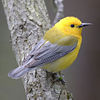Owl
| Owl Fossil range: 58 Ma Late Paleocene – Recent |
||||||||||||||
|---|---|---|---|---|---|---|---|---|---|---|---|---|---|---|
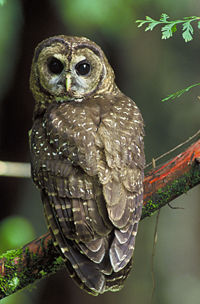 The rare Northern Spotted Owl
Strix occidentalis caurina |
||||||||||||||
| Scientific classification | ||||||||||||||
|
||||||||||||||
| Families | ||||||||||||||
|
Strigidae |
||||||||||||||
| Synonyms | ||||||||||||||
|
Strigidae sensu Sibley & Ahlquist |
The Owls are an order of birds of prey. Most are solitary, and nocturnal, with some exceptions (e.g. the Burrowing Owl). They are classified in the order Strigiformes, in which there are over 200 extant species. Owls mostly hunt small mammals, insects, and other birds, though a few species specialize in hunting fish. They are found in all regions of the Earth except Antarctica, most of Greenland, and some remote islands. Though owls are typically solitary, the literary collective noun for a group of owls is a parliament.
The living owls are divided into two families, the typical owls, Strigidae, and the barn-owls, Tytonidae.
Contents |
Description
Owls have large forward-facing eyes and ear-holes, a hawk-like beak, a flat face, and usually a conspicuous circle of feathers around each eye called a facial disc. Although owls have binocular vision, their large eyes are fixed in their sockets, as with other birds, and they must turn their entire head to change views.
The smallest owl is the Elf Owl (Micrathene whitneyi), at as little as 31 g (1.1 oz) and 13.5 cm (5.3 inches). Some of the pygmy owls are scarcely larger. The largest owls are two of the eagle owls, the Eurasian Eagle Owl (Bubo bubo) and Blakiston's Fish Owl (Bubo blakistoni), which may reach a size of 60-71 cm (28.4 in) long, have a wingspan of almost 2 m (6.6 ft), and weight of nearly 4.5 kg (10 lb).
Owls are far-sighted, and are unable to see anything clearly within a few inches of their eyes. Caught prey can be felt by owls with the use of filoplumes, which are small hair-like feathers on the beak and feet that act as "feelers". Their far vision, particularly in low light, is exceptionally good. They can turn their head 135 degrees in either direction; they can thus look behind their own shoulders.
Different species of owls make different sounds; the wide range of calls aids owls in finding mates or announcing their presence to potential competitors, and also aids ornithologists and birders in locating these birds and recognizing species. The facial disc helps to funnel the sound of prey to their ears. In many species, these are placed asymmetrically, for better directional location (Cotty, 2008).
Owl eggs are usually white and almost spherical, and range in number from a few to a dozen, depending on species. The eggs are laid in intervals of 1–3 days and do not hatch at the same time. This accounts for the wide variation in the size of sibling nestlings. Owls do not construct nests but rather look for a sheltered nesting site or an abandoned nest, in trees, underground burrows, or in buildings, barns and caves.
Behavior
Most owls are nocturnal, actively hunting for prey only under the cover of darkness. Several types of owl, however, are crepuscular, or active during the twilight hours of dawn and dusk; one example is the pygmy owl (Glaucidium). A few owls are also active during the day; examples are the Burrowing Owl (Speotyto cunicularia) and the Short-eared Owl (Asio flammeus). The time at which an owl hunts can be determined by the colour of its eyes. Dark brown or black eyes indicate nocturnal activity, orange indicates dawn or dusk, and owls with yellow eyes are diurnal and hunt during the day. There are exceptions to this general rule, however, so the colour of an owl's eyes is not the only indicator of its active hours.

Much of the owl's hunting strategy depends on stealth and surprise. Owls have at least two adaptations that aid them in achieving stealth. First, the dull coloration of an owl's feathers can render them almost invisible under certain conditions. Secondly, serrated edges on the leading edge of the owl's remiges muffle the owl's wingbeats, allowing its flight to be practically silent. Some fish-eating owls, where this silence is of no evolutionary advantage, lack this adaptation.
Once prey has been captured, the owl's sharp beak and powerful talons allow it to kill its prey before swallowing it whole (unless it is too big). Scientists studying the diets of owls are helped by their habit of regurgitating the indigestible parts of their prey (such as bones, scales and fur) in the form of pellets. These "owl pellets" are often sold by companies to schools to be dissected by students as a lesson in biology and ecology, because they are plentiful and easy to interpret.[1]
Evolution and systematics
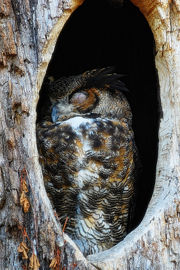
The systematic placement of owls is disputed. For example, the Sibley-Ahlquist taxonomy finds that, based on DNA-DNA hybridization, owls are more closely related to the nightjars and their allies (Caprimulgiformes) than to the diurnal predators in the order Falconiformes; consequently, the Caprimulgiformes are placed in the Strigiformes, and the owls in general become a family Strigidae. This is not supported by more recent research.[2] In any case, the relationships of the Caprimulgiformes, the owls, the falcons and the accipitrid raptors are not resolved to satisfaction; currently there is an increasing trend to consider each group (with the possible exception of the accipitrids) a distinct order.
There are some 220–225 extant species of owls, which are subdivided into two families; typical owls (Strigidae) and barn-owls (Tytonidae). Some entirely extinct families have also been erected based on fossil remains; these differ much from modern owls in being less specialized or specialized in a very different way (such as the terrestrial Sophiornithidae). The Paleocene genera Berruornis and Ogygoptynx show that owls were already present as a distinct lineage some 60-58 mya (million years ago), and presumably also some 5 million years earlier, at the extinction of the non-avian dinosaurs. This makes them one of the oldest known groups of non-Galloanserae landbirds. The supposed "Cretaceous owls" Bradycneme and Heptasteornis are apparently non-avialan maniraptors.[3]
During the Paleogene, the Strigiformes radiated into ecological niches now mostly filled by other groups of birds. The owls as we know them today, on the other hand, evolved their characteristic morphology and adaptations during that time too. By the early Neogene, the other lineages had been displaced by other bird orders, leaving only barn-owls and typical owls. The latter at that time were usually a fairly generic type of (probably earless) owl similar to today's North American Spotted Owl or the European Tawny Owl; the diversity in size and ecology found in typical owls today developed only subsequently.
Around the Paleogene-Neogene boundary (some 25 mya), barn-owls were the dominant group of owls in southern Europe and adjacent Asia at least; the distribution of fossil and present-day owl lineages indicates that their decline is contemporary with the evolution of the different major lineages of typical owls, which for the most part seems to have taken place in Eurasia. In the Americas, there was rather an expansion of immigrant lineages of ancestral typical owls.
The supposed fossil herons "Ardea" perplexa (Middle Miocene of Sansan, France) and "Ardea" lignitum (Late Pliocene of Germany) were more probably owls; the latter was apparently close to the modern genus Bubo. Judging from this, the Late Miocene remains from France described as "Ardea" aureliensis should also be restudied.[4] The Messelasturidae, some of which were initially believed to be basal Strigiformes, are now generally accepted to be diurnal birds of prey showing some convergent evolution towards owls. The taxa often united under Strigogyps[5] were formerly placed in part with the owls, specifically the Sophiornithidae; they appear to be Ameghinornithidae instead.[6]
For fossil species and paleosubspecies of extant taxa, see the genus and species articles.
Unresolved and basal forms (all fossil)
- Berruornis (Late Paleocene of France) - basal? Sophornithidae?
- Strigiformes gen. et ap. indet. (Late Paleocene of Zhylga, Kazakhstan)
- Palaeoglaux (Middle – Late Eocene of WC Europe) - own family Palaeoglaucidae or Strigidae?
- Palaeobyas (Late Eocene/Early Oligocene of Quercy, France) - Tytonidae? Sophiornithidae?
- Palaeotyto (Late Eocene/Early Oligocene of Quercy, France) - Tytonidae? Sophiornithidae?
- Strigiformes gen. et spp. indet. (Early Oligocene of Wyoming, USA)[7]
Ogygoptyngidae
- Ogygoptynx (Middle/Late Paleocene of Colorado, USA)
Protostrigidae
- Eostrix (Early Eocene of WC USA and England - Middle Eocene of WC USA)
- Minerva (Middle – Late Eocene of W USA) - formerly Protostrix, includes "Aquila" ferox, "Aquila" lydekkeri, and "Bubo" leptosteus
- Oligostrix (mid-Oligocene of Saxony, Germany)
Sophiornithidae
- Sophiornis
Strigidae: Typical owls
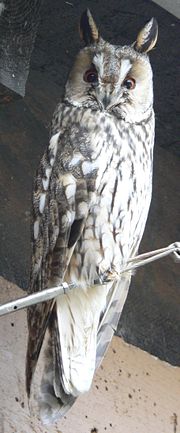
- Aegolius: saw-whet owls, four species
- Asio: eared owls, 6–7 species
- Athene: 2–4 species (depending on whether Speotyto and Heteroglaux are included or not)
- Bubo: horned owls, eagle-owls and fish-owls; paraphyletic with Nyctea, Ketupa and Scotopelia, some 25 species
- Ciccaba: four species
- Glaucidium: pygmy-owls, about 30–35 species
- Gymnoglaux: Bare-legged Owl or Cuban Screech-owl
- Jubula: Maned Owl
- Lophostrix: Crested Owl
- Megascops: screech-owls, some 20 species
- Micrathene: Elf Owl
- Mimizuku: Giant Scops-owl or Mindanao Eagle-owl
- Ninox: Australasian hawk-owls, some 20 species
- Nesasio - Fearful Owl
- Otus: scops-owls; probably paraphyletic, about 45 species
- Pseudoscops: Jamaican Owl and possibly Striped Owl
- Ptilopsis: white-faced owls, two species
- Pulsatrix: spectacled owls, three species
- Pyrroglaux: Palau Owl
- Strix: earless owls, about 15 species
- Surnia: Northern Hawk-owl
- Uroglaux: Papuan Hawk-owl
- Xenoglaux: Long-whiskered Owlet
- Mascarenotus: Mascarene owls, three species; extinct (c.1850)
- Sceloglaux: Laughing Owl; extinct (1914?)
- Grallistrix: stilt-owls, four species; prehistoric
- Ornimegalonyx: Caribbean giant owls, 1–2 species; prehistoric
Fossil genera
- Mioglaux (Late Oligocene? - Early Miocene of WC Europe) - includes "Bubo" poirreiri
- "Otus/Strix" wintershofensis: fossil (Early/Middle Miocene of Wintershof West, Germany) - may be close to extant genus Ninox[7]
- Intutula (Early/Middle –? Late Miocene of C Europe) - includes "Strix/Ninox" brevis
- Alasio (Middle Miocene of Vieux-Collonges, France) - includes "Strix" collongensis
Placement unresolved
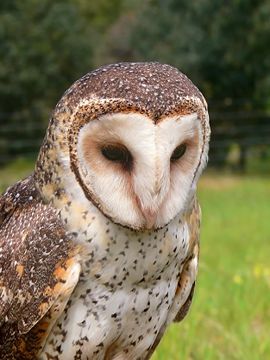
- "Strix" edwardsi: fossil (Middle Miocene)
- "Asio" pygmaeus: fossil (Early Pliocene of Odessa, Ukraine)
- Ibiza Owl, Strigidae gen. et sp. indet.: prehistoric[8]
Tytonidae: Barn-owls
- Genus Tyto: typical barn-owls, stand up to 3 feet (0.91 m) tall some 15 species and possibly one recently extinct
- Genus Phodilus: bay-owls, 1–2 extant species and possibly one recently extinct
Fossil genera
- Nocturnavis (Late Eocene/Early Oligocene) - includes "Bubo" incertus
- Necrobyas (Late Eocene/Early Oligocene - Late Miocene) - includes "Bubo" arvernensis and Paratyto
- Selenornis (Late Eocene/Early Oligocene) - includes "Asio" henrici
- Prosybris (Early Oligocene? - Early Miocene)
Placement unresolved
- Tytonidae gen. et sp. indet. "TMT 164" (Middle Miocene) - Prosybris?
Relationship with humans
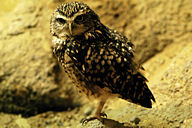
Owls have been a feature of falconry for years. In recent years, many owls have moved from their previous rural habitats to start to inhabit urban areas. The Tawny Owl has been a common visitor to cities across the UK for about forty years, where it survives on a diet of pigeons and small birds. Owls in urban areas are also known to prey on new-born kittens.[9]
In many parts of the world, owls have been associated with death and misfortune, likely due to their nocturnal activity and common screeching call. However, owls have also been associated with wisdom and prosperity, frequently being companion animals for goddesses. In Hindu Mythology, the barn owl is considered to be vehicle of Goddess Lakshmi (Goddess of Wealth) and thus it is considered lucky if an owl resides near your house.
Henry David Thoreau summarized one perception of owls, when he wrote in 1854's Walden, "I rejoice that there are owls. Let them do the idiotic and maniacal hooting for men. It is a sound admirably suited to swamps and twilight woods which no day illustrates, suggesting a vast and underdeveloped nature which men have not recognized. They represent the stark twilight and unsatisfied thoughts which all [men] have."
Owls and their use as rodent control
Encouraging natural predators to control rodent population is a natural form of pest control along with exclusion of food sources for rodents. Placing a new box for owls on a property can help control rodent populations (one family of hungry barn owls can consume more than 3,000 rodents in a nesting season) while maintaining the naturally balanced food chain.[10]
Owls are also known to become victims of secondary poisoning by eating mice or rats that have previously been poisoned with rodenticides.
Africa
|
Ancient Egyptians used a representation of an owl for their hieroglyph for the sound m. They would often draw this hieroglyph with its legs broken to keep this bird of prey from coming to life..
Among the Kikuyu of Kenya it was believed that owls were harbingers of death. If one saw an owl or heard its hoot someone was going to die. In general, owls are viewed as harbingers of bad luck, ill health, or death. The belief is widespread even today.[11]
The Americas
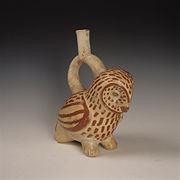
In the culture of the Hopi nation, taboos surround owls and they are associated with evil or sorcery. In the United States, as with eagle feathers, the possession of owl feathers as religious objects is regulated by federal law (e.g. The Migratory Bird Treaty Act of 1918 and Title 50 Part 22 Code of Federal Regulations).
The Aztecs and Mayans, along with other natives of Mesoamerica, considered the owl a symbol of death and destruction. In fact, the Aztec god of death, Mictlantecuhtli, was often depicted with owls. There is an old saying in Mexico that is still in use (considered politically incorrect): Cuando el tecolote canta, el indio muere ("When the owl cries/sings, the Indian dies"). The Popol Vuh, a Mayan religious text, describes owls as messengers of Xibalba (the Mayan "Place of Fright").[12]
Other Native American tribes saw the owl as the carrier of the elders' spirits.
The Moche people of ancient Peru worshipped the animal and often depicted owls in their art.[13]
In some parts of Brazil, especially in the states of São Paulo and Minas Gerais, hear the whistle of an owl or find one is a sign of bad omen.
Asia
In Japanese culture, owls are seen as either negative or positive symbols depending on species. Sometimes owls are seen as divine messengers of the gods, while Barn or Horned owls are perceived as demonic figures.
In Indian culture, a white owl is considered a companion and vahana (Vehicle of god/goddess) of Lakshmi, the goddess of wealth, and therefore a harbinger of prosperity. The owl has been adapted as an emblem to reflect its implications of wisdom (Wise old owl) by a revered military institution in India known as the Defense Services Staff College. In colloquial use, however, it is commonly used to refer to stupidity. The Hindi word for owl, ulloo is used to refer to a foolish person.
The demoness Lilith is thought to have been associated with (screech) owls as well, by way of the KJV translation of the passage in Isaiah 34:14. Prior to the rise of Islam, owls were considered bad omens and associated with evil spirits in most Middle Eastern pagan traditions. In modern times, although such superstitions are less prevalent, owls are still popularly considered "evil" because of their fierce appearance.
In the Malay language, owls are called "burung hantu", literally 'ghost bird'.
Europe
In Greek mythology, the owl, and specifically the Little Owl, was often associated with the goddess Athena, a bird goddess who became associated with wisdom, the arts, and skills, and as a result, owls also became associated with wisdom. They are the unofficial mascot of the high-IQ society Mensa.
The Romans, in addition to having borrowed the Greek associations of the owl (see Owl of Minerva), also considered owls to be funerary birds, due to their nocturnal activity and often having their nests in inaccessible places. As a result, seeing an owl in the daytime was considered a bad omen. For example, in Book 12 of Virgil's Aeneid, an owl appears before Turnus toward the end of his battle with Aeneas, prefiguring his death, and "a strange, numbing dread / Washed through Turnus' body; his hair / Bristled with fear; his voice stuck in his throat."[14] The vampiric strix of Roman mythology was in part based on the owl.
Likewise, in Romanian culture, the mournful call of an owl is thought to predict the death of somebody living in the neighbourhood. Such superstitions caused a minor disturbance when an owl showed up at Romanian President's residence, Cotroceni Palace.
In France, a difference is made between hiboux, eared owls, which are considered symbols of wisdom, and chouettes, earless owls, which are considered birds of ill omen.
In the Welsh Cycles of the Mabinogion, the Owl is considered cursed - the first owl was Blodeuedd, a woman born of flowers to be the wife of Lleu Llaw Gyffes. Because she fell in love with another man and plotted to kill Lleu, Lleu's guardian Gwydion turned her into the first owl, saying "You are never to show your face to the light of day, rather you shall fear other birds; they will be hostile to you, and it will be their nature to maul and molest you wherever they find you. You will not lose your name but always be called Blodeuwedd." The addition of the w in her name changed her from a woman of flowers to an owl.
In Finland the owl is paradoxically viewed as both a symbol of wisdom, and as a symbol of imbecility, presumably because of its "dumb stare".
Owl is the name of Pooh Bear's wise friend in the famous childhood stories by A.A. Milne.
The two largest cities in Yorkshire, UK- Leeds and Sheffield both feature Owls in their civic culture. Owls, feature on the Leeds coat of arms, as used by Leeds City Council and formerly by Leeds United Football Club, while in Sheffield they are the symbol of the cities most successful football club Sheffield Wednesday, who are even nicknamed 'The Owls'.
Footnotes
- ↑ "Owl Pellets in the Classroom: Safety Guidelines".
- ↑ See Haaramo (2006). In reality, the presumed distant relationship of the accipitrids - namely, the "Accipitriformes" according to Sibley and Ahlquist (1990) - with owls (and most other bird lineages) is most likely due to systematic error. Accipitrids have undergone drastic chromosome rearrangement and thus appear in DNA-DNA hybridization generally unlike other living birds.
- ↑ Mortimer (2004)
- ↑ Olson (1985): pp.131, 267
- ↑ Mayr (2005)
- ↑ Alvarenga & Höfling (2003), Peters (2007)
- ↑ 7.0 7.1 Olson 1985: p.131
- ↑ Sánchez Marco (2004)
- ↑ "Owls culprits in cat deaths". Retrieved on 2008-02-14.
- ↑ http://www.hungryowl.org/
- ↑ Owls in Lore and Culture - The Owl Pages
- ↑ "The Popol Vuh". Retrieved on 2008-07-23.
- ↑ Berrin & Larco Museum (1997)
- ↑ Virgil, Aeneid, trans. Stanley Lombardo (Indianapolis: Hackett, 2005): 12.1047-49.
References
- Alvarenga, Herculano M. F. & Höfling, Elizabeth (2003): Systematic revision of the Phorusrhacidae (Aves: Ralliformes). Papéis Avulsos de Zoologia 43(4): 55-91 [http://www.scielo.br/scielo.php?): The Spirit of Ancient Peru:Treasures from the Museo Arqueológico Rafael Larco Herrera. Thames and Hudson, New York.
- Calaprice, Alice & Heinrich, Bernd (1990): Owl in the House: A Naturalist's Diary. Joy Street Books, Boston. ISBN 0316354562
- Haaramo, Mikko (2006): Mikko's Phylogeny Archive: "Caprimulgiformes" - Nightjars. Version of 2006-MAY-11. Retrieved 2007-NOV-08.
- Heinrich, Bernd (1987): One Man's Owl
- Johnsgard, Paul A. (2002): North American Owls: Biology and Natural History, 2nd ed.. Smithsonian Institution Press, Washington DC. ISBN 1-56098-939-4
- Mayr, Gerald (2005): "Old World phorusrhacids" (Aves, Phorusrhacidae): a new look at Strigogyps ("Aenigmavis") sapea (Peters 1987). PaleoBios (Berkeley) 25(1): 11-16 HTML abstract
- Mortimer, Michael (2004): The Theropod Database: Phylogeny of taxa. Retrieved 2008-AUG-14.
- Norberg, R.A. (1977): Occurrence and independent evolution of bilateral ear asymmetry in owls and implications on owl taxonomy. Philosophical Transactions of the Royal Society of London, Series B, Biological Sciences 280: 375-408.
- Olson, Storrs L. (1985): The fossil record of birds. In: Farner, D.S.; King, J.R. & Parkes, Kenneth C. (eds.): Avian Biology 8: 79-238. Academic Press, New York.
- Peters, Dieter Stefan (2007): The fossil family Ameghinornithidae (Mourer-Chauviré 1981): a short synopsis. Journal of Ornithology 148(1): 25-28. doi:10.1007/s10336-006-0095-z PDF fulltext
- Sánchez Marco, Antonio (2004): Avian zoogeographical patterns during the Quaternary in the Mediterranean region and paleoclimatic interpretation. Ardeola 51(1): 91-132. PDF fulltext
- Sibley, Charles Gald & Monroe, Burt L. Jr. (1990): Distribution and taxonomy of the birds of the world: A Study in Molecular Evolution. Yale University Press, New Haven, CT. ISBN 0-300-04969-2
External links
General
- Owl species of the World
- Animal Diversity Web Page: Owls
- Owl Brain Atlas
- Smithsonian Snowy Owl Info
- Owls of the Harry Potter movies - learn about the owls featured in the films, threats to the species, and conservation activities
- World Owl Trust
- Owl Physiology, 'The Owl Pages' website.
- Migratory Bird Treaty Act of 1918
- Athenian Owl coins
- Silent kill: The kingdom of owl, photos of different owl species with music - by Liagen
Eurasia
- World of Owls - Northern Irelands only Owl, Bird of Prey and Exotic Animal Centre.
- Current Blakiston's Fish Owl Research in Russia
North America
- List of Owl Species Breeding In North American and Owl Photos
- South Okanagan Rehabilitation Centre For Owls (British Columbia)
Australia
|
||||||||||||||||||||||||||
![G17 [m] m](/2009-wikipedia_en_wp1-0.7_2009-05/I/hiero_G17.png)
